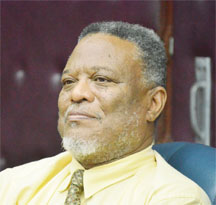Unwilling to write off the prospects offered by the Amaila Falls Hydropower Project, the government could move for a referendum on the project, according to Prime Minister Samuel Hinds.
“I am going to go to the people of Guyana. I am urging that maybe we make it a referendum issue—that we go to the people of Guyana about it. This is not a political issue, this is not a party question, this is a question about getting power at about 50% of the cost,” Hinds told reporters on Friday, while emphasising that he is willing to do whatever is necessary to bring the project to fruition.
Developer Sithe Global walked from the project in August in wake of its failure to win the unanimous political backing due to main opposition APNU’s refusal to support enabling parliamentary measures. Sithe was slated to invest US$157 million in equity while Guyana was to invest US$100 million. This was just part of the funding, however, since US$500 million and US$100 million were to be contributed by the China Development Bank (CDB) and the Inter-American Development Bank (IDB), respectively, in loans.

Sithe, however, was the entity soliciting the loans and with the company’s exodus the majority of the funds that were to be used for the project’s completion is no longer available. Furthermore, the IDB study into the GPL’s ability to efficiently manage the power that would have come from the project, which Hinds said is about 90% complete, has been put on hold since it was initiated with the assumption that the project would be going ahead.
Hinds, however, said he had not given up. “Whatever is required to have Amaila happen, this Prime Minister is willing to do it to make Amaila happen,” he declared. Even when he was asked what other prospects were being looked at, since it seemed that Amaila was not an immediate reality, he said, “I am not accepting that Amaila is not an immediate reality, I refuse to accept that Amaila is not an immediate reality.”
Having noted the unlikelihood of seeing this ambition materialise through deliberation in National Assembly, the Prime Minister said he may seek to have the decision made through a referendum.
Hinds said that he was baffled as to why APNU, of which the People’s National Congress (PNC) is the main constituent, would shoot down the project, especially since the party hailed it as important several decades ago.
According to the Prime Minister, the pursuit of hydroelectricity was hailed as a good idea and Amaila was identified by the PNC as one of the best sites to fit Guyana’s electricity needs. This assessment was made, he said, in 1972 and then again in 1982 when a re-assessment was done.
Recalling this support, Hinds said that when he brought the project forward, he did not anticipate the opposition’s resistance and admitted that he was caught “flatfooted” when they did decide to oppose its completion.
Both the AFC, which first opposed the project then supported it, and APNU, which opposed the project to the end, have indicated that they are not against hydropower for Guyana, but rather the way in which the project was being conducted.
There were concerns that the reduced tariff cost projected by Sithe and the Government of Guyana would not take place. Instead, several critics, including Christopher Ram, had said that the cost might have actually increased. Furthermore, many were not in agreement with the reality that the government would have owned 40% of the investment, while Sithe, whose equity investment was larger, would have owned 60%.
In terms of the loans that would have been contributed, Ramon Gaskin, an analyst, argued that the 7.2% that would have had to be paid to the China Development Bank and the 9% that would have gone to the Inter-American Development Bank would have been too high. He said that 2% was more reasonable, although Hinds insisted that the interest rates were reasonable since Guyana is no longer a Heavily Indebted Poor Country and does not benefit from the preferential treatment afforded to such countries.
If Amaila is made a reality, Hinds reiterated, Guyana can see tariff rates going down gradually to about 11 cents/ kWh in the first year of operations, and by the end of 20 years, when the company is transferred, production costs would be around 2 cents. These figures, he said, are far better than those currently being seen with the use of Heavy Fuel Oil (HFO). As things stand, the cost per kWh is about 23 cents, he said.
Even the 19% returns which Sithe would have benefited from, Hinds argued, is reasonable, especially when one considers the fact that “tight negotiations” saw the government beating the company down from 25%. In 2003, Hinds disclosed, Synergy had invited another company to take part in the project. This company, who the Prime Minister did not name, reportedly refused to budge in the demand for a 25% return.
This, coupled with their insistence on transferring the company at commercial rates as opposed to by the dollar, signaled the death of that prospect, he said, because the government was not willing to pay such a high price.
Hinds maintained that the deal struck with Sithe was the best that could be arrived at, and he seemed confident that steps could be taken to bring the project back on track. It is with this optimism that he shared his belief that despite the set-back, the project can still come online in four to five years.
But time is wasting, he said, while adding that every day lost is another day of high tariffs sustained. He even offered to spend a week to trek through the details of Amaila, so as to give the public a better understanding of the project and its intricacies.




